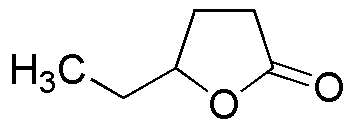g-Hexalactone is widely utilized in research focused on various applications:
- Flavor and Fragrance Industry: This compound is commonly used as a flavoring agent in food products and as a fragrance in cosmetics, providing a creamy, coconut-like aroma that enhances sensory appeal.
- Pharmaceuticals: g-Hexalactone serves as a key intermediate in the synthesis of various pharmaceutical compounds, contributing to the development of new medications with improved efficacy.
- Biodegradable Plastics: It is incorporated into the production of biodegradable polymers, promoting environmentally friendly alternatives to traditional plastics, which is crucial for sustainability efforts.
- Aromatherapy: The compound is used in essential oils and aromatherapy products, offering calming effects that can help reduce stress and promote relaxation.
- Research and Development: g-Hexalactone is a valuable reagent in organic synthesis, aiding researchers in developing new chemical processes and materials with unique properties.
General Information
Properties
Safety and Regulations
Applications
g-Hexalactone is widely utilized in research focused on various applications:
- Flavor and Fragrance Industry: This compound is commonly used as a flavoring agent in food products and as a fragrance in cosmetics, providing a creamy, coconut-like aroma that enhances sensory appeal.
- Pharmaceuticals: g-Hexalactone serves as a key intermediate in the synthesis of various pharmaceutical compounds, contributing to the development of new medications with improved efficacy.
- Biodegradable Plastics: It is incorporated into the production of biodegradable polymers, promoting environmentally friendly alternatives to traditional plastics, which is crucial for sustainability efforts.
- Aromatherapy: The compound is used in essential oils and aromatherapy products, offering calming effects that can help reduce stress and promote relaxation.
- Research and Development: g-Hexalactone is a valuable reagent in organic synthesis, aiding researchers in developing new chemical processes and materials with unique properties.
Documents
Safety Data Sheets (SDS)
The SDS provides comprehensive safety information on handling, storage, and disposal of the product.
Product Specification (PS)
The PS provides a comprehensive breakdown of the product’s properties, including chemical composition, physical state, purity, and storage requirements. It also details acceptable quality ranges and the product's intended applications.
Certificates of Analysis (COA)
Search for Certificates of Analysis (COA) by entering the products Lot Number. Lot and Batch Numbers can be found on a product’s label following the words ‘Lot’ or ‘Batch’.
*Catalog Number
*Lot Number
Certificates Of Origin (COO)
This COO confirms the country where the product was manufactured, and also details the materials and components used in it and whether it is derived from natural, synthetic, or other specific sources. This certificate may be required for customs, trade, and regulatory compliance.
*Catalog Number
*Lot Number
Safety Data Sheets (SDS)
The SDS provides comprehensive safety information on handling, storage, and disposal of the product.
DownloadProduct Specification (PS)
The PS provides a comprehensive breakdown of the product’s properties, including chemical composition, physical state, purity, and storage requirements. It also details acceptable quality ranges and the product's intended applications.
DownloadCertificates of Analysis (COA)
Search for Certificates of Analysis (COA) by entering the products Lot Number. Lot and Batch Numbers can be found on a product’s label following the words ‘Lot’ or ‘Batch’.
*Catalog Number
*Lot Number
Certificates Of Origin (COO)
This COO confirms the country where the product was manufactured, and also details the materials and components used in it and whether it is derived from natural, synthetic, or other specific sources. This certificate may be required for customs, trade, and regulatory compliance.

